What to do after the orchid has bloomed, features of care during the dormant period
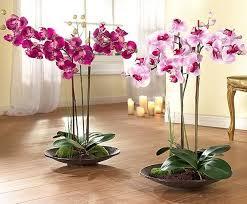
Orchid cannot be called an unpretentious plant. But all the difficulties of care are more than compensated by its beauty during the flowering period. In order for an orchid to regularly please the eye with buds, it is important to follow all the subtleties of growing.
Content:
- Orchid blossom
- What care will ensure optimal flowering?
- What to do after the orchid has bloomed
- Basic principles of plant care during the interflowering season
Bloom
The flowering period for orchids is on average 3 months. Some varieties bloom all year round.
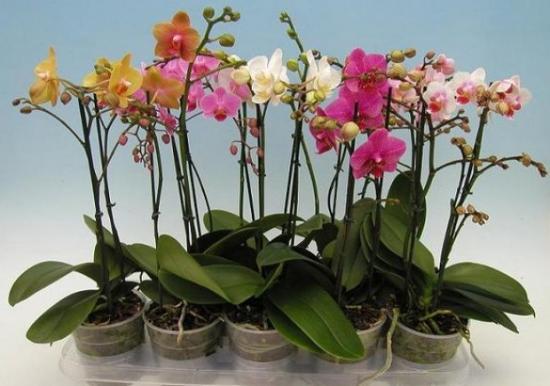
This period may be reduced for the following reasons:
- When purchasing a plant with flowers, you should consider the likelihood that it bloomed a long time in the store. In this case, you won’t be able to enjoy the beautiful petals for long.
- At temperatures above 30 C they drop their flowers for several days. Too warm air provokes active leaf growth to the detriment of flowering.
- Incorrectly selected fertilizers can dry out the roots of the plant. In this case, the flowers fall off.
- Abundant watering causes rotting of the roots, which provokes a reduction in flowering time.
It is important to remember that flowering begins at 1.5 - 3 years. If flowers do not appear, the plant may not have reached the desired age. At the same time, when flowering at a young age orchids quickly deplete and die. Before purchasing, you need to check the age of the plant.
After the flowers fall off, re-blooming rarely occurs.She is quite capricious and needs special care at every stage of her life.
What care will ensure optimal flowering?
In order to admire flowers for as long as possible, and more than once, you must follow all the rules of caring for them during the growth period, during the appearance of flowers and in the inter-flower season.
Factors that influence flowering activity.
Lighting
Plants are extremely light-loving. For normal life, they need good lighting for half the day. At the same time, it is necessary to protect plant from direct sunlight. It is optimal to place pots on the southeast or east side to avoid excess sun in summer and lack of sun in winter.
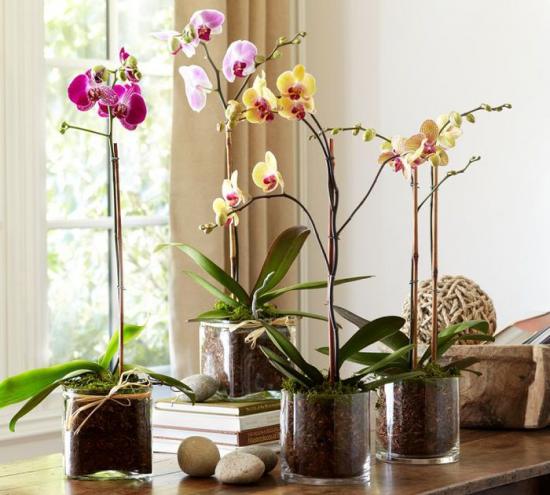
In the cold season, when daylight hours are shortened, phytolamps should be used. They provide optimal illumination without drying out the air. Lamps should be positioned so that they do not burn the stems or leaves.
Some varieties can easily tolerate a lack of light, but most varieties orchids they even lose young buds if they are too dark.
Air temperature
Flowers do not tolerate both cold and heat. The optimal temperature for them is 23-28 C. It is important to ensure temperature changes. At night it should be 4-6 C cooler than during the day.
In the warm season, it is recommended to take flowers outside or onto the balcony. If this is not possible, you should at least open the windows in the room. The main thing is to ensure that it is protected from drafts.
Do not increase the air temperature in winter. On the contrary, it is worth providing some coolness at this time of year. It is necessary to bring the conditions of detention as close as possible to the natural habitat.
Humidity
Flower native to the tropics, where there is high humidity.In order for a beauty to feel comfortable indoors, it is important to create a suitable microclimate for her. There should always be water in the pan.
The main thing is that the roots do not come into contact with it, otherwise they will rot. It is recommended to place a container of water next to the pot, and regularly spray the plant itself with a spray bottle. Installing an electric humidifier will be useful. Optimal air humidity is 60-80%.
Watering
Watered orchid when the soil dries out. Watering is moderate. This applies to adult plants and young shoots. Excess moisture causes roots to rot. The most water is needed before it blooms and during the flowering process. But after flowering during the inter-flowering season, watering is reduced to once every week and a half.

Some varieties require year-round watering. You need to take this into account when caring for your pet.
Top dressing
Fertilizers containing phosphorus and potassium are useful for orchids. The plant responds well to feeding with succinic acid. But nitrogen-containing ones inhibit flowering.
It is worth giving preference to products designed specifically for orchids and strictly follow the instructions for use. It is usually recommended to fertilize twice a month, stopping feeding during the off-flower season.
Root care
Orchid roots need sunlight. Therefore, it is best to plant the plant in transparent containers with holes to allow excess moisture to drain out and air to enter. You should choose dishes with smooth, even walls, since the roots grow to a rough and curved surface.
Moving
Orchids do not like transplanting. In addition, they will react negatively to moving the potty. The container should be in a constant place with the same side facing the light source.
Stress
Often orchids don't rush to please with flowers because they are too comfortable. They use all their energy to develop shoots and leaves. In order for buds to appear, they must be “scared”. To do this, it is enough to create drought conditions. Watering is reduced by half, spraying and fertilizing are stopped. It may also be helpful to temporarily move the pot or lower the air temperature.
What to do after the orchid has bloomed
After the flowering period, the orchid begins the interflowering season. At this time, fertilizing and watering are limited, but the same lighting is maintained. Most often this happens in winter.
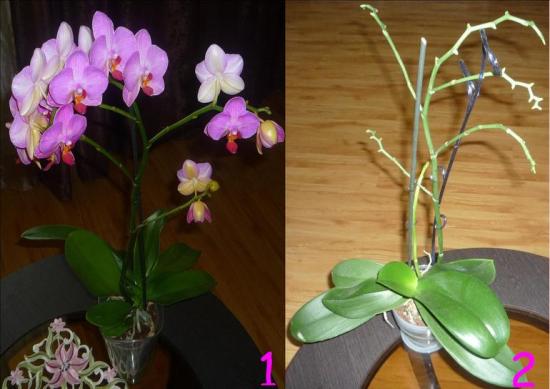
Beginning flower growers are wondering what to do with the arrow when the orchid has faded? Should I trim it? orchid after flowering? If the orchid has faded, how to replant it?
The peduncle should be removed only after it has dried. If the arrow is completely dry, it is cut off at a distance of 2-2.5 cm from the base. In case of partial drying, only the dry tip is removed, leaving the green part of the peduncle. Perhaps the orchid will still have time to please with fresh flowers before it finally goes into hibernation.
Removing the arrow is mandatory. A blackened peduncle does not look aesthetically pleasing; in addition, it takes away some of the plant’s nutrients.
Pruning done with sharp scissors or a knife. The instrument is pre-disinfected using alcohol or calcination. The cut area of the plant is treated with brilliant green or activated carbon powder.
The cut green arrow of some varieties is used for propagation by cuttings, provided that at least one bud is preserved on it. The chance of survival is low, but possible under favorable conditions.
The cuttings are planted in a greenhouse with high humidity and an air temperature of 25-28 C.Moss is used instead of soil.
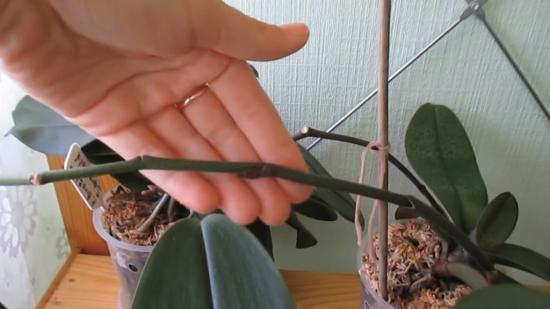
Often, flowering takes away all the vitality from a plant. Not everyone knows what to do if an orchid has faded and dries out. In this case, the arrow is cut off almost completely, leaving no more than 1.5 cm. Not a single bud should be left on it. If the orchid blooms again, it will completely weaken it.
After pruning, the plant is left alone and the necessary conditions are provided:
- sufficient lighting;
- low temperature;
- reduction of watering;
- stopping feeding.
If the orchid feels fine, you can think about transplantation. Replanting helps to improve the health of the plant and allows it to develop further.
You can tell when it’s time to move your pet into a new container by looking at the roots. If they stick out from the drainage holes, it means you need a larger pot. The need for a transplant appears every 2-3 years. If you disturb the plant more often, it will go into hibernation for a long time or die.
The transplant must be carried out as carefully as possible so as not to damage the delicate flower. To make it easier to get it out of the container, water the soil generously.
After extraction, you should carefully examine the roots. Dried and rotten areas are cut off. The remaining roots are not touched. If you try to untangle them, you can damage the system.
The new pot should be slightly larger than the previous one. Several drainage holes are made in it. To ensure that the roots receive the required amount of light, it is better to take a transparent container.
A drainage layer of fine crushed stone or granite chips is placed at the bottom of the pot. The soil can be purchased ready-made, with a special composition for orchids. Experienced flower growers prepare the mixture themselves.
Optimal components for soil.
Charcoal
Natural antiseptic.When crushed, it provides water balance. The finished soil should contain no more than 10% coal, otherwise excess salts will accumulate in it.
Moss
Gives the soil looseness and sufficient moisture. It is first scalded with boiling water and dried. After replanting, cover the surface of the soil with moss. The layer should be changed every six months.
Humus
The main part of the soil. Obtained from fallen leaves. Supplies orchid roots with nutrients and beneficial microflora.
pine bark
Provides additional drainage. It is removed from healthy trees. Before mixing, the bark is disinfected and dried. Possible combined use with pine cones.
The soil mixture is calcined to get rid of insects and larvae. The plant is placed in a pot at the same level at which it grew before and covered with soil.
When transplanted correctly, the orchid quickly takes root. It does not require support or soil compaction.
After transplantation, the plant is not watered. It is sprayed generously and left alone. If everything is done correctly, flowering will occur again in 2-3 months.
Some varieties go dormant for a longer period. If this is not the case, and the plant still does not bloom, most likely the conditions for keeping the orchid are not observed correctly.
Basic principles of plant care during the interflowering season
In order for the plant to exit dormancy in a timely manner and flowering to occur quickly, it is necessary to adhere to the basic rules.

Reduce watering
During the inter-flowering period, watering is carried out no more than once every 10 days. Some gardeners recommend reducing watering to once a month. If the variety does not go into hibernation, watering remains the same all year.
Stopping feeding
During the inter-flowering season, nutrient processing does not occur. Fertilizer is useless at this time.
Air humidification
Heating in winter dries out the air, so humidification should be a priority during this period. But spraying the leaves is not recommended. When at rest they can rot.
Additional lighting
To maintain the duration of daylight at 10-12 hours, phytolamps are used. They are placed at a distance of 20-30 cm from the plant.
Temperature reduction
During the inter-flowering season, the temperature should be slightly lower than the rest of the time - at least 150C at night and 230C during the day. In this case, as always, you need to avoid drafts and contact of leaves with a cold window.
Capricious flower requires careful adherence to all care rules. If you take this issue seriously, she will regularly delight others with beautiful flowers.
Detailed information about caring for orchids during the dormant and flowering periods is in the video that we offer for viewing:

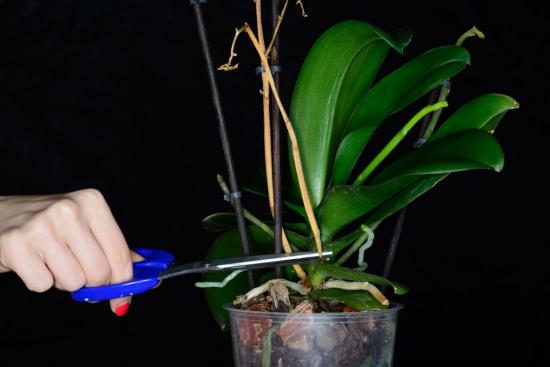
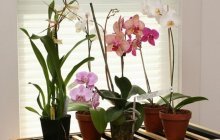
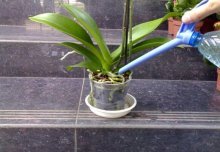
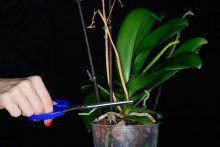
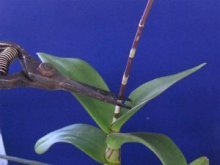
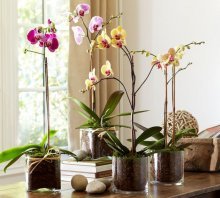
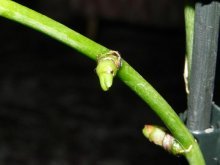

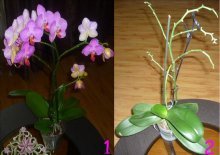
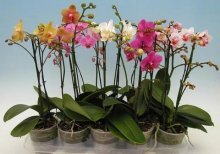

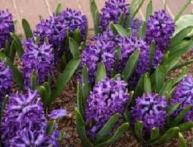
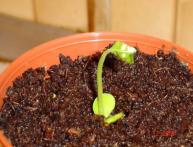
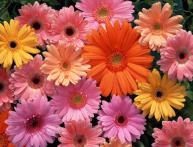
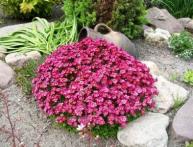
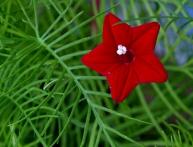
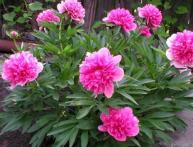

Comments
The article was written very intelligently, I learned a lot of new and interesting things. And I completely agree. Trim the peduncle only (!) after it dries. It is important! Limit watering for the winter, and do not change the place on the windowsill. This is the key to success.
And I water the orchid the same way, regardless of whether it blooms or not. I increase the lighting in winter using a special lamp. I didn’t notice that it became weak for me, the only thing was that I had to replant it once, because... the soil was covered with a white coating.
Orchid is one of my favorite indoor flowers, but care is really difficult and takes a lot of time and effort.Many species do not take root with me, so I concluded that each type of orchid requires its own conditions. But the fact that they don’t like bright light and excessive watering is 100%.
I’m still tormented: to throw away the orchids or not. It turns out that either the leaves are growing well, or the flowers are blooming) nothing together. I read somewhere about watering that you should not water the orchids from a watering can, but put them in a bowl of water and keep them there for more than an hour. I tried to do this, but in one orchid I changed the soil, which I bought in the store - in the end it became moldy... I’ll try to apply your advice, maybe I’ll somehow bring my flowers back to normal!